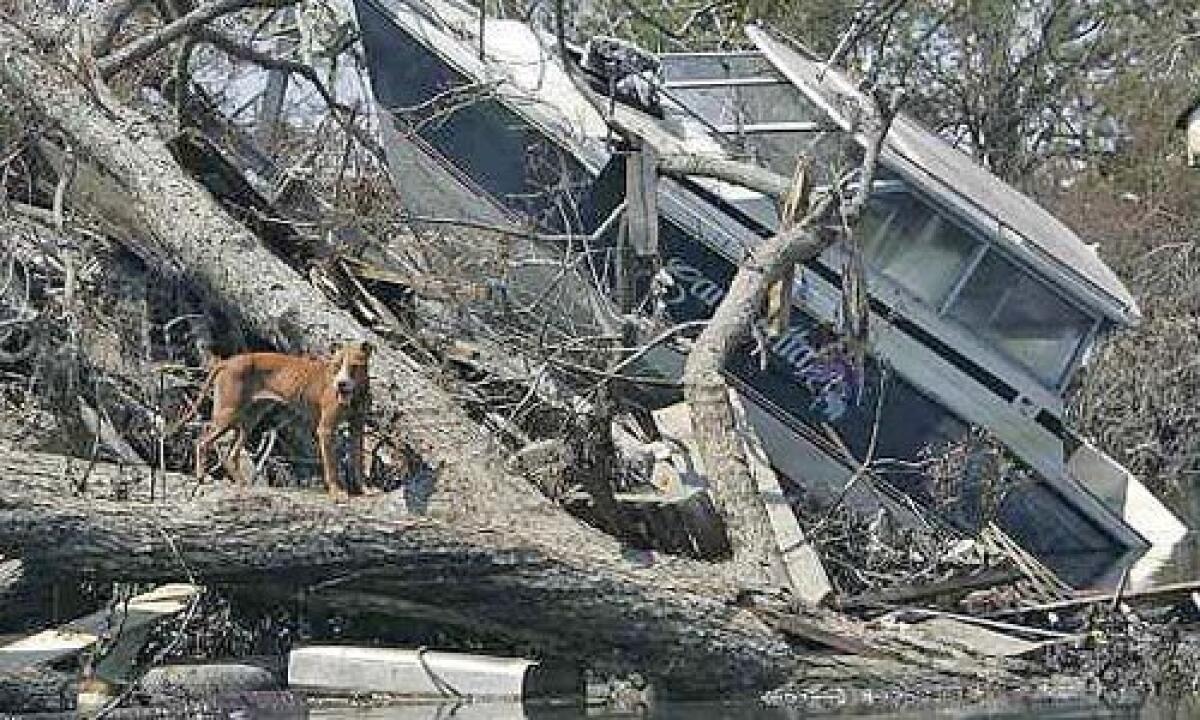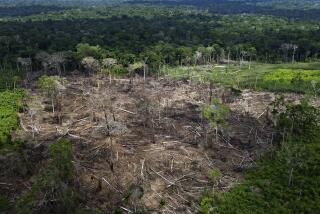Katrina leaves permanent scar on forests

- Share via
An analysis of satellite imagery of the Gulf Coast shows that Hurricane Katrina destroyed an estimated 320 million trees in Mississippi and Louisiana, an unprecedented loss of forestland that will reshape the region for generations, Louisiana researchers reported today.
The death of the trees from wind damage and soaking in saltwater will ultimately release about 367 million tons of carbon dioxide as they decompose -- about the same amount that is absorbed by all U.S. forests in a year, according to the study published in the journal Science.
Considered on the vast scale of global climate change, Katrina’s impact is small. But as a one-time event, its infusion of carbon is significant, exceeding an entire season’s worth of emissions from U.S. forest fires.
“This is a one-shot massive hit to these systems, where you see this enormous impact,” said Jason Neff, an assistant professor of geoscience at the University of Colorado at Boulder, who was not involved in the study.
Most of the lost trees in the Gulf region stood 70 to 100 feet tall, and others will not grow back for decades, if ever, experts said.
Hurricane Katrina, which made landfall in August 2005 with winds that reached 125 mph, damaged 5 million acres of forests, 80% of them in Mississippi, according to the U.S. Forest Service. By comparison, the 1980 eruption in Washington of Mt. St. Helens wiped out 150,000 acres of forest.
“In some areas of southeast Louisiana and southeast Mississippi, it was 100% damage,” said Wayne Hagan, founder of Timberland Management Services of Louisiana in Clinton. “I had one landowner on 2,000 acres who had basically $4 million worth of trees on his place. One hundred percent of the trees were blown over and broken down. That’s basically what the hurricane did.”
Biologist Jeffrey Q. Chambers of Tulane University and his colleagues said the deforested land, once covered with native species such as longleaf pine, oak and cypress, is being taken over by invasive species that are changing the ecology of the area. One of the most prolific, the Chinese tallow, oozes a milky, toxic sap that creates an inhospitable environment for insects, birds and small animals.
The trees that are growing back represent only a fraction of those destroyed, and they are surrounded by large quantities of decomposing lumber. Combined with the drought now punishing the South, that is the recipe for a devastating forest fire, said James L. Cummins, executive director of the Mississippi Fish and Wildlife Foundation.
“If we have significant fires, all of those young trees are going to be toast,” he said.
Chambers and his colleagues at Tulane and the University of New Hampshire estimated the damage using images from NASA’s Landsat 5 satellite taken in May 2003 and June 2006.
The images from the satellite’s spectrometers enabled them to distinguish live trees from dead ones and from other vegetation. Those data were verified by analyzing selected tracts on the ground, Chambers said by phone from Brazil, where he is studying the Amazon forest.
“I was amazed,” he said. “I didn’t expect that much damage.”
The extent of losses was highly dependent on the type of tree in the hurricane’s path. Only about 10% of stands of loblolly pine, favored by commercial timber growers, survived the assault.
In contrast, more than 90% of native longleaf pine stands escaped damage. But the acreage of longleaf pine is only about 2% of what it was a century ago, Cummins said.
The only timber stands that survived were ones planted in the last 20 years, Hagan said. Those trees were planted close together, so they were able to support each other through the high winds. “One tree leans on another,” he said.
Experts said they expected that most of the lost forestland would never be replanted.
Most of the people who lost trees in the hurricane were tree farmers, and replacing the felled trees in the months after the storm was not a high priority.
Farming trees “is hardly ever the only thing a private landowner does,” said Amanda Box, a spokeswoman for the Mississippi Forestry Assn. in Jackson, Miss. “I may also have cattle, and I may be a schoolteacher.”
The federal government earmarked $504 million for tree replacement, but the program typically provides only half the cost of replanting, along with a small stipend -- as low as a net of $100 per acre in some areas -- to keep the trees growing for a decade.
Owners struggling to rebuild their homes and businesses in the wake of Katrina weren’t able to make up the difference, Hagan said, and many sold their land to people who used it for residential construction.
Only about $70 million in government funds has been disbursed, and no more than 100,000 acres have been replanted, Cummins said.
Forestry advocates are pressing landowners to tap into those funds. More forest recovery money will become available in the spring, Box said.
“It’s a major push here, and it’s still ongoing,” she said.
But it is probably too late to make a difference, Hagan said.
“If you don’t plant it the first year, then the vegetation grows up and it costs you about four times as much to plant,” he said. “When you miss the boat the first time, it doesn’t get planted.”
Times staff writer Alan Zarembo contributed to this report.







